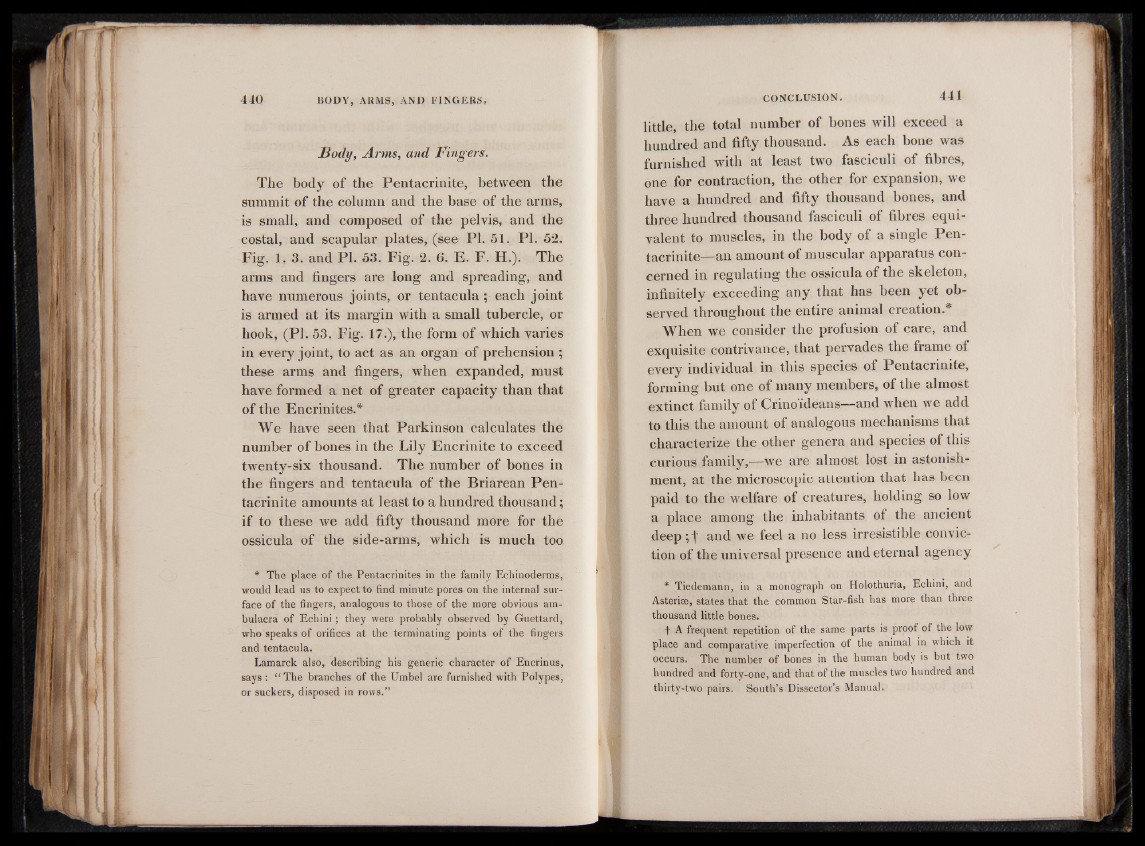
Body, Arms, and Fingers.
The body of the Pentacrinite, between the
summit of the column and the base of the arms,
is small, and composed of the pelvis, and the
costal, and scapular plates, (see PI. 51. Pl. 52.
Fig. 1. 3. and PI. 53. Fig. 2. 6, E. F. H.), The
arms and fingers are long and spreading, and
have numerous joints, or tentacula; each joint
is armed at its margin with a small tubercle, or
hook, (PI. 53. Fig. 17.), the form of which varies
in every joint, to act as an organ of prehension ;
these arms and fingers, when expanded, must
have formed a net of greater capacity than that
of the Encrinites.*
We have seen that Parkinson calculates the
number of bones in the Lily Encrinite to exceed
twenty-six thousand. The number of bones in
the fingers and tentacula of the Briarean Pentacrinite
amounts at least to a hundred thousand;
if to these we add fifty thousand more for the
ossicula of the side-arms, which is much too
* The place of the Pentacrinites in the family Echinoderms,
would lead us to expect to find minute pores on the internal surface
of the fingers, analogous to those of the more obvious ambulacra
of Echini; they were probably observed by Guettard,
who speaks of orifices at the terminating points of the fingers
and tentacula.
Lamarck also, describing his generic character of Encrinus,
says : “ The branches of the Umbel are furnished with Polypes,
or suckers, disposed in rows.”
little, the total number of bones will exceed a
hundred and fifty thousand. As each bone was
furnished with at least two fasciculi of fibres,
one for contraction, the other for expansion, we
have a hundred and fifty thousand bones, and
three hundred thousand fasciculi of fibres equivalent
to muscles, in the body of a single Pentacrinite—
an amount of muscular apparatus concerned
in regulating the ossicula of the skeleton,
infinitely exceeding any that has been yet observed
throughout the entire animal creation.*
When we consider the profusion of care, and
exquisite contrivance, that pervades the frame of
every individual in this species of Pentacrinite,
forming but one of many members, of the almost
extinct family of Crinoideans—and when we add
to this the amount of analogous mechanisms that
characterize the other genera and species of this
curious family,—we are almost lost in astonishment,
at the microscopic attention that has been
paid to the welfare of creatures, holding so low
a place among the inhabitants of the ancient
deep;"I* and we feel a no less irresistible conviction
of the universal presence and eternal agency
* Tiedemann, in a monograph on Holothuria, Echini, and
Asterioe, states that the common Star-fish has more than three
thousand little bones.
f A frequent repetition of the same parts is proof of the low
place and comparative imperfection of the animal in which it
occurs. The number of bones in the human body is but two
hundred and forty-one, and that of the muscles two hundred and
thirty-two pairs. South’s Dissector’s Manual.